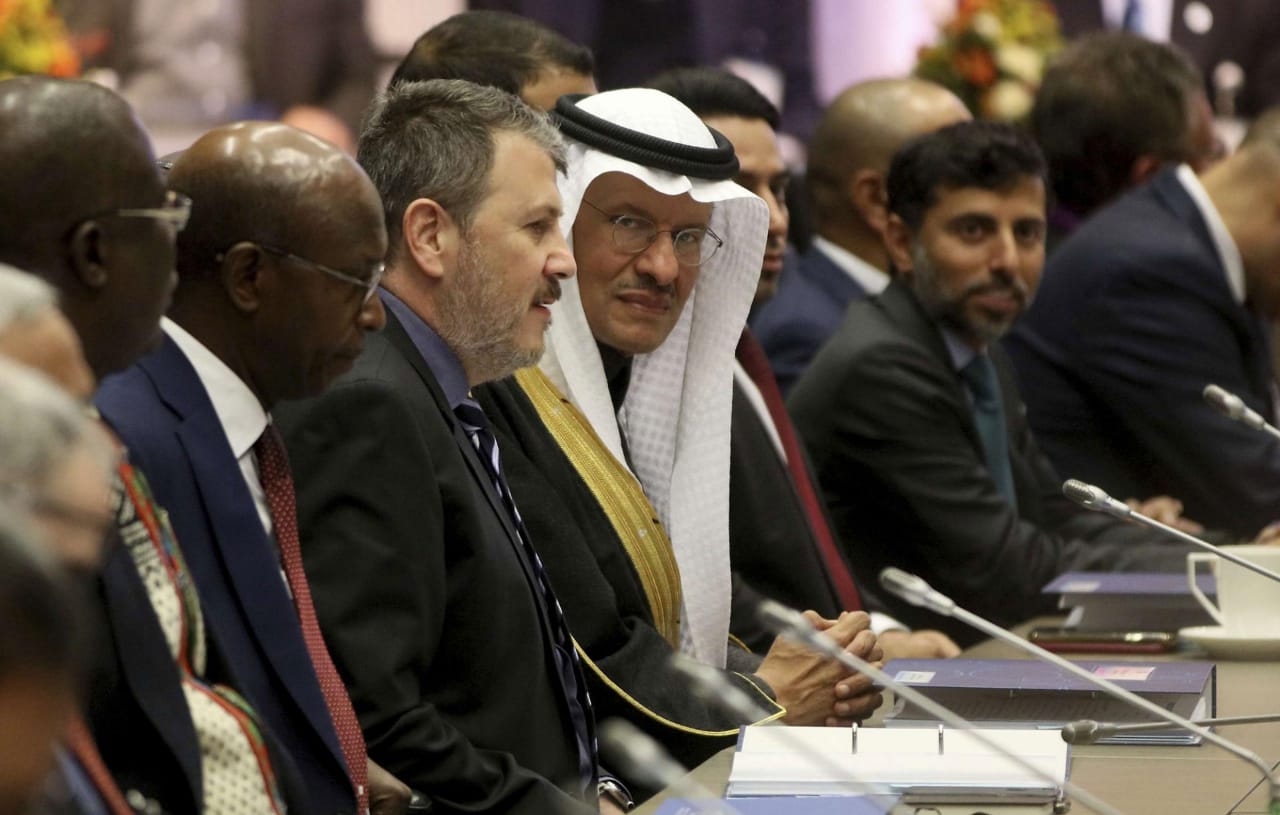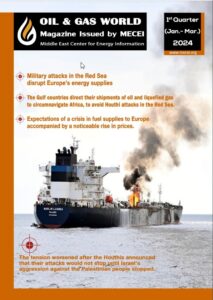- ASRY Awarded 2024 RoSPA Gold Medal in Health and Safety
- BP ponders shifting focus away from renewables, say sources
- QatarEnergy enters 10-year naphtha supply agreement with Japan’s ENEOS Corporation
- The International Energy Agency expects oil demand growth to slow in 2024
- The International Monetary Fund re-selects Kristalina Georgieva as its director
- Libya to target producing 1.4 million b/d by end 2024
- TotalEnergies launches the Marsa LNG project and deploys it multi-energy strategy in Oman
- H.E. Minister Al-Kaabi: Demand for oil and gas will continue for long; we have to be responsible, and Qatar is doing its part
- Egypt to stop exporting LNG starting from the beginning of May 2024
- QatarEnergy selects Nakilat to own and operate 25 conventional LNG vessels

The dangers surrounding OPEC In 2020 (Crisis coincidence and safe solutions)

During the first half of 2020, the world has suffered from three strong crises (one after the other) in such a way that didn’t allow a breathtaking. These crises are:
1 – The health crisis caused by the spread of the Corona virus from China, the largest importer of crude oil, which in return led to a decline in the global demand for oil.
2- The economic crisis that started in China due to the confrontation with the United States has been deepened with the adverse effect of the Corona virus, and spread to reach the United States and countries in Europe.
3- The emerging oil supply crisis due to the dispute between Russia and Saudi Arabia over the method of deepening production cuts within the (OPEC +) group to confront the weak oil demand, which led to the statements released by OPEC as well as by Russia that the restrictions of OPEC production will stop by the end of March 2020, and that all the oil producing countries can produce without restrictions. This resulted in a sharp fall of the oil prices within days from about $50/bbl of Brent crude to about $29/bbl (which is the largest drop in nearly 30 years).
OPEC vision
The Global demand for oil in 2019 has witnessed a relatively low growth due to the commercial war between China and the United States and the drop in the Chinese Economy growth. It was hoped that the implementation of the first stage of the trade agreement between the two countries will lead to a rapid rise in the global demand for oil during 2020. However, the outbreak of the Corona virus at the beginning of this year shattered the hopes of the oil market, and there are bleak expectations about the growth of oil demand and economic activity this year.
How did the events result in the drop of the oil prices to this dangerous level? A question that presents itself, and to know the answer it is necessary to briefly review what happened in the last OPEC meeting.
During its meeting in Vienna, the capital of Austria, on 5 and 6 March 2020, the OPEC statement had confirmed that the global oil demand in 2020 was greatly affected due to the spread of the virus (COVID-19) in nearly 50 countries, and that a declination in the global economic growth is expected, and thus the rate of growth in global oil demand this year will drop to only 500 thousand barrels per day.
According to a Reuter’s survey, it appeared that OPEC crude oil production in February 2020 had dropped to its lowest levels in ten years (27.8 million b/d), as Libya’s production was continuing to decline, and as some of the other producers had also reduced their production more than what was agreed. Iraq & Nigeria were the only two producers that have exceeded the agreed production amounts.
On the eve of the aforementioned OPEC meeting, some sources had estimated that the global oil market is now suffering from an increased glut of more than 4 million barrels per day. It became obvious that to absorb the oil market glut OPEC countries have to reduce their production by these amounts, which is impossible to implement as it will cause a severe damage to the economies of oil producing countries. Therefore, during the deliberations of the meeting, OPEC issued a final warning to all its members calling for a reduction of 1.5 million barrels per day in addition to the previous reduction of 1.7 million barrels per day. This reduction will be distributed among the group, so that OPEC countries will cut one million barrels per day, and non-OPEC countries will cut half a million barrels per day.
Saudi stance
Saudi Arabia was seeking to find a way to absorb the excess oil supply in the market with the aim of stopping the decline in oil prices or at least slowing it down.
Despite the decline in OPEC oil production and in its market share to unprecedented levels during the past ten years, Saudi Arabia sought at the meeting to obtain collective approval from the OPEC countries to carry out further reductions in oil production in cooperation with Russia.
There have been direct deliberations and negotiations between the two countries (Saudi Arabia and Russia) to coordinate oil production in order to strengthen its prices. Saudi Arabia stipulated that the reduction agreement is to be accompanied by Russia’s approval and involvement, but the latter refused to agree for further reductions in production. Saudi Arabia was left with no other option but for OPEC solely (without Russia) to implement the reduction agreement which Saudi Arabia considered not sufficient to restore the balance to the market.
Russian stance
During the past three years, the Russian administration has been cooperating with OPEC in its decisions to reduce the production, with the aim of restoring the balance in the oil market so that the oil prices can improve. But Russia now believes that the new reductions in oil output will not have a remarkable impact on the oil prices, especially in circumstances where the oil demand is declining due to the spread of the Corona virus, which explains the Russian refusal to sign an agreement to reduce production within the OPEC group.
Russian President Vladimir Putin stated by then that his country can adapt with the current weak oil prices, and that Russia can afford low oil prices because the he parity price in the Russian budget is 42.4 dollars per barrel, compared to about 85 dollars per barrel in Saudi Arabia and most of the other OPEC members.
The Russian decision was supported by the Russian oil companies that opposed further production cuts as they need a quick return on their huge investments to expand production capacity in recent years. The Russian sides were convinced that production cuts will deliver the lifeline to the American shale oil producers, which will harm them and other OPEC oil producers at the end.
The disagreement and its implications
After the Russian rejection of Saudi Arabia’s request to join oil production cuts, the Saudi position has been changed completely and the Kingdom switched from requesting joint cuts to take an individual decision to increase its production.
At the time, His Royal Highness Prince Abdulaziz bin Salman, Minister of Energy, stated that each of oil producing country should maintain its market share. He pointed out that in the absence of an agreement to counter the impact of the Corona virus that’s affecting oil demand and prices, he perceived that there is no need to hold a meeting of (OPEC +) group in the period from May to June 2020.
This was followed by the statement of Eng. Amin Al-Nasser, President of Saudi Aramco, which is the largest energy company in the world and responsible for pumping 10% of the global crude oil supplies, stating that it will raise its production from the current 9.7 million barrels per day to an average of 12.3 million barrels per day as of April 1, An increase of 300 thousand barrels per day from the company’s maximum sustainable capacity of 12 million barrels per day. Some analysts described this decision as Saudi Arabia will flood the oil markets with additional quantities of 2.6 million barrels per day.
Saudi Arabia also announced that it will reduce the official selling prices of its crude by 6-8 dollars per barrel, as of the beginning of April 2020, which the highest discounts offered to Saudi oil buyers in Europe and the United States. These developments led to the failure of the (OPEC+) group meeting to reach an agreement, thereby stopping the three-year coordination between Saudi Arabia, Russia and other oil producing countries, and was followed by a significant decline in world oil prices.
On the Russian side, the Minister of Energy Alexander Novak said that Russia will also start pumping more oil at the beginning of April 2020, and that after three years of reducing supplies to support prices, the rest of the countries will be also freed from the production quotas and reductions that were in effect earlier, however each country must constantly monitor and analyze the market developments. Thus the world oil market is heading towards deepening the excess production.
Opportunities for convergence of divergent views
Observers believe that the current crisis in the oil markets is worse than the global economic downturn of 2008 and the consequent decline in oil demand. To overcome the crisis at that time, OPEC cut its production so that oil demand could recover. But in 2020, there are signs of an unprecedented new crisis due to the increase in oil supply coinciding with the decrease in demand for it, which led to a sharp drop in oil prices, while OPEC did not succeed in reaching an agreement with its main ally which is “Russia”.
Many analysts are now skeptical about the possibility of covering the gap in the OPEC alliance, and some even see what happened as a failure to hold the OPEC organization itself together. They also see that even if the group (OPEC+) is able to meet again and agree on deeper reductions, it will be too late especially that the global economy and the global oil demand were severely affected by the outbreak of the Corona virus.
On the other hand, some other analysts sees that it might still be possible to make some political agreements on a higher level with Russia and other OPEC countries, with the aim of coordinating production levels among them. This approach can avoid the damages that will result from the continuation of the current situation which will adversely affect all producing countries from inside and outside OPEC.
This team of analysts believes that Russia may return under OPEC’s umbrella reluctantly, and with less contribution to the required reductions, just to maintain good and beneficial relations of cooperation with OPEC until conditions could be improved and the ghost of Corona virus vanishes later by the end of 2020 or by 2021.
This possibility is supported by statements given by the Russian President Putin in which he said: “Although Russia’s international reserves are sufficient, but that does not negate our need to work jointly with our foreign partners, and that the coordination with OPEC+ group has already proven to be an effective tool to ensure long-term stability in global energy markets.”. He also added that he still considers “the cooperation with OPEC as being positive, because it enabled Russia to gain additional budget revenues and had provided the capabilities for our oil extraction companies to invest in promising development projects.” The oil companies and the Russian Oil Ministry says that they do not yet rule out the possibility of reviving the good relationship with Saudi Arabia by returning to cooperation with OPEC if necessary.
Future prospects for OPEC and the global oil market
There is no doubt that the sharp decline in oil prices will lead to a reduction in exploration and production activities in many regions of the world during the years 2020 and 2021, and this may be accompanied by the entry of the Eurozone into an economic recession.
In the United States, the suffering of shale oil companies began despite their attempts to cope with the sharp decline in oil prices. Some of these companies have found themselves compelled to reduce their operations and reduce the number of rigs, which will satisfy the traditional oil producers in the OPEC group, because it will accelerate the cohesion of the markets due to the suspension or reduction of the production of shale oil companies.
Besides, the lowering of interest rates by central banks around the world will revive economic growth and thus increase demand for oil. And with the entry of the summer season, a rise in temperature will reduce the spread of the Corona virus, and the opportunity will be ripe for the recovery of global demand for oil, especially since governments in Asia, Europe and America are now making tremendous efforts to support companies and strengthen health systems to counter the emerging virus. Adding to the same direction, the World Bank Group has allocated 14 billion dollars to support the program to combat the spread of the virus.
With regard to the recent repercussions witnessed by OPEC recently, according to our vision in the Middle East Energy Information Center (MECEI), we expect the current crisis between the major oil producers (Saudi Arabia and Russia) to soon disappear, and we also expect a close meeting to organize production within the OPEC + alliance. Our conviction is based on a set of considerations, the most important of which are the following:
- Saudi Arabia and Russia were hoping that the continued decline in oil prices would lead to the exit of high-cost oil producers from the market (especially American shale oil producers), so that the supplies offered would decrease, the markets would be balanced and prices would improve again. But these hopes may not be fulfilled, because most of the shale oil producers in America have a high ability to adapt to low oil prices, and they have even previously succeeded in passing a similar test imposed on them by the former Saudi Oil Minister Ali Al-Naimi, who said it openly to representatives of shale oil companies in The Sarawick conference in Houston, “Whoever cannot stand up like us and bear the low prices of oil, stop production and exit the market.” Therefore, the continuation of the current disintegration of the Organization of Petroleum Exporting Countries (OPEC) and indifference to the price drop, claiming that it will destroy others, will only achieve a heavy loss for OPEC countries because they have accepted the sale of their oil at low prices, and this is a waste of the wealth of future generations. In other words, it may take a long time for the shale oil companies to leave the market arena and during which OPEC countries have depleted a large part of their wealth. Therefore, it is necessary to reconcile and return to the negotiating table to coordinate production in order to raise oil prices again.
- International oil prices deteriorated significantly in the second half of March 2020 compared to their level during the deliberations between the two countries (Saudi Arabia and Russia) in the previous OPEC meeting, which resulted in disagreement between them. On the eve of the meeting, prices had fallen to $ 37 a barrel, a price that Russia saw at that time close to the equivalent price in the Russian budget of $ 42.4 a barrel, and that the Russian economy could therefore adapt to this low price. However, in the following days, prices fell further to $27 for Brent oil, and the difference between this new price and the breakeven price in the Russian budget came to be ($15), and therefore there is no meaning for the possibility of the adjustment hopes of President Putin, and that Russia will not be able to hold on for a long time on its position with Low prices at this level, especially with the current dumping of cheap oil by Saudi Arabia.
- As for the Kingdom of Saudi Arabia, which has announced its intention to open the taps of oil production to increase exports and bring in revenues that cover the budget burdens and compensate for the big difference between the current market price of $27 a barrel and the equivalent price in the Saudi budget of $85 a barrel. Of course, Saudi Arabia can do that, and it can chart for itself a path that combines increasing oil production and selling it at low prices at the same time, helped by the low cost of producing a barrel of Saudi oil. However, this path will harm the wealth of future generations represented in the huge oil reserves that could have been kept in the ground without being harmed or spoiled by their stay in the reservoirs until prices improve.. And therefore, this trend cannot last for long.










